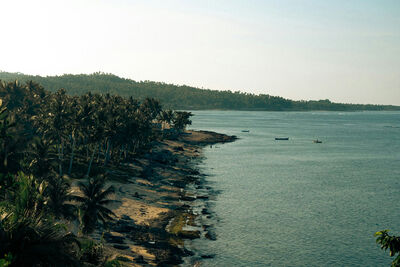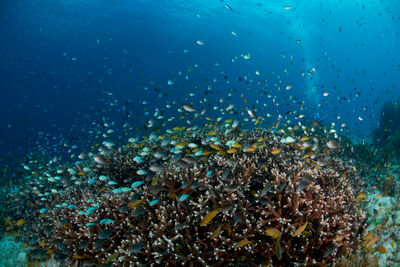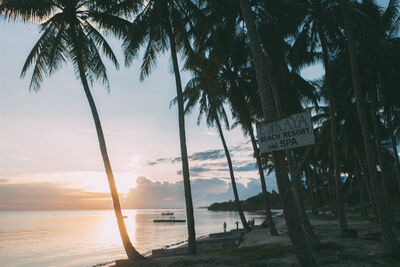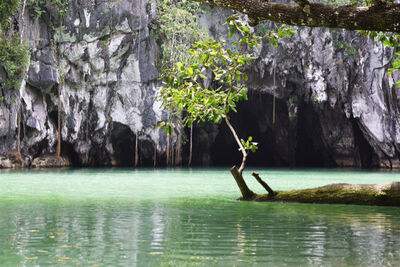Named after King Philip II of Spain, the Philippines is a sun-kissed island nation in Southeast Asia. With over 100 million people, a whopping 7,000 (and counting) islands and an impressive ten seas, the Philippines is a seriously diverse nation rich in history, culture and traditions. Ready to learn more about what makes this smattering of islands oh-so tempting? Read on for our top ten Philippines facts…

1. The Philippines has 7,641 islands (for now)
For a long time, the official number of islands in the Philippines was said to be 7,107. However, that number isn't quite right. In 1952, Didicas (a submerged volcano in the Luzon Volcanic Chain) erupted. The result? A new island with a lava dome that rose about 228m above sea level, bumping the total island count to 7,108… for a short while, anyway.
As well as this new island, improvements in surveying techniques and technology have also led to an increase in the number of islands believed to be in the archipelago. There are also a few islands whose ownership is up for debate. The Spratly Islands in the South China Sea, for example, are disputed between several nations: Vietnam, Brunei, China, Malaysia, Taiwan and the Philippines. With all these changes, the official number of islands is now officially touted to be 7,641 - an island-hopper's paradise.
2. The Philippines endured Spanish and American colonial rule
Before its independence in 1946, the Philippines was ruled by the Spanish and the Americans for over three centuries. This colonisation began in 1565 when Spanish explorer Miguel Lopez de Legazpi arrived from New Spain (modern-day Central America). The Spanish ruled until the Spanish-American War ended, and the Americans took over control of the Philippines.
Both Spanish and American influences are still felt today in the Philippines. The Spanish left their mark on the language, with many Spanish terms woven into local Filipino languages. Religion was also shaped by the Spanish - the Philippines is today one of two Asian countries to be predominantly Catholic (the other is Timor-Leste). The Americans, on the other hand, influenced the government and education system. Today, Philippines is a constitutional republic with a president, and the brief period of American rule also explains why the English language is so widely spoken across the archipelago.

3. The Philippines is a megadiverse country
To be labelled as megadiverse, a country needs to be home to numerous endemic species as well as myriad species of flora and fauna. And the Philippines more than fits the bill: there are an estimated 13,500 plant species in the country (with 3,500 of them being endemic), and the jungles and rainforests house around 8,000 flowering plant species (including 998 orchid species alone). As for the fauna, the Philippines has 167 land mammals (102 endemic species), 235 reptiles (160 endemic species), 99 amphibians (74 endemic species), 686 birds (224 endemic species) and over 20,000 insect species. Impressive.
The Philippines is equally blessed below the waves as it is on land. The islands sit at the top of the Coral Triangle - the global hotspot for marine biodiversity. Overall, the Philippines is home to over 3,200 fish species, including some that are hard to encounter anywhere else, like the thresher sharks of Malapascua. From the shores of its islands, you can also spot one of the smallest fish species in the world (the teeny-tiny Philippine goby) and the world's biggest fish (the whale shark) as well as thousands of other species whose size falls between the two extremes.
4. The Philippines caters to different dive tastes
The Philippines isn't just diverse above water: its diving is extremely varied too. Find everything from muck diving in Anilao and Dauin to drift diving in Puerto Galera and Bohol. Head to Coron for incredible shipwrecks, or to Cebu's Malapascua and Moalboal for encounters with thresher sharks. One of the most exciting Philippines facts is that there's something here for every diver.
And then there's the jewel in the crown: Tubbataha Reef. This UNESCO World Heritage site sits in the middle of the Sulu Sea and is only reachable via liveaboard. Due to the open nature of the reef - it's around 90 miles from shore - it also has a short diving season. The window only runs from March to June, but the reward for those who venture out there is undeniable: whale sharks, tiger sharks, manta rays, hammerhead sharks, turtles and Napoleon wrasse will all be vying for your attention.

5. The Philippines is blessed with beautiful beaches
There's just as much to enjoy in the Philippines above the surface as there is beneath the waves. The islands are blessed with an abundance of beautiful beaches, and in most places, dive sites are a short bangka ride away from shore. These traditional Philippine boats usually return to the dive centre after each dive (typically around ten minutes away, though there are also further day trips available), allowing ample time to lie on the silky sands.
Alona Beach, on Panglao Island in Bohol, is ideal for chilling after dives on nearby Napaling Reef. There's also Bounty Beach in Malapascua, White Beach in Puerto Galera and Waling Waling Beach in Coron, all idyllic places to catch a few rays or, if you've finished diving, a cheeky Tanduay (local rum) at sunset.
6. The Philippines sits on the western edge of the Ring of Fire
The Ring of Fire surrounds the Pacific Ocean, with the Philippines located on the vast ocean's western edge. According to the Philippine Institute of Volcanology and Seismology, the country is home to 380 volcanoes: 25 active, 28 potentially active, and 327 (thankfully) inactive. Of these numerous Philippine calderas, Taal Volcano, Mount Pinatubo and Mayon Volcano are the most famous.
Taal Volcano is a three-hour drive south of Manila and is close to the muck diving mecca of Anilao. It's famous for being a 'volcano within a lake, within a volcano' - Volcano Island sits within the lake that fills the caldera of Taal Volcano. Mount Pinatubo, 60 miles northwest of Manila, is renowned for its 1991 eruption - the 20th century's second largest. And Mayon Volcano is seen as one of the most beautiful in the world due to its almost perfectly symmetrical cone shape.

7. The Philippine tarsier is one of the world’s smallest primates
These days, tarsiers only exist in Southeast Asia, mainly in Brunei, Indonesia, Malaysia and the Philippines. The Philippine tarsier is endemic to the Philippines, and the little cuties look like something from Star Wars - a cross between Yoda and an Ewok. They may be small - not much taller than six inches - but they have an entirely carnivorous diet (mainly insects and spiders).
One of the best places to see the Philippine tarsier is Bohol, in the Visayas. The island is not only home to the Philippine tarsier but also the famous Chocolate Hills - nicknamed as such because in the dry season the green grass covering the hills turns a chocolate brown. Bohol Island is also famous for the stunning Alona Beach, and the diving around Panglao and the Balicasag Marine Sanctuary is well worth checking out.
8. In Malapascua, the early bird catches (sight of) the thresher shark
The small island of Malapascua, off the northern tip of Cebu, is the only known location in the world where divers can see thresher sharks on a daily basis. Monad Shoal is a sunken island a short bangka ride from Bounty Beach. The shoal is surrounded by deep water, which is where the threshers spend most of their time. When they need a trip to the salon, they head to the relative shallows of Monad Shoal to spend some time circling the cleaning stations.
As deep-water sharks, though, the threshers don't like bright light. And they're early risers. They come up to the cleaning stations early in the morning (very early in the morning!) before the sun gets too high. Boat departure times for the thresher shark dives are usually between 4am and 5am. You can also dive Monad Shoal in the afternoons, when you're more likely to see manta rays and devil rays cruising by the cleaning stations.

9. On Palawan, you can cruise down an underground river
The Puerto Princesa Underground River was, until fairly recently, believed to be the longest such river in the world (Sistema Sac Actun on Mexico's Yucatan Peninsula has since been declared as being longer). While it may no longer be the world record holder, cruising down this darkened waterway by boat is still quite the experience. The river is a short drive north from Puerto Princesa City, and after enjoying the caves, stalactites and stalagmites that have been formed by thousands of years of flowing water, you can head to nearby Sabang Beach to get reacquainted with the sun.
After a global poll to find the 'New 7 Wonders of Nature', the Puerto Princesa Underground River was declared one of the seven winners. It makes for an intriguing stop-off on the way to or from the luxurious resorts, lagoons and limestone cliffs of El Nido and Coron in northern Palawan. The northern tip of Palawan is also famous for its WWII wreck diving.
10. The Philippines is a great spot for underwater photography
Whether you've just bought your first underwater camera system or are an old hand at snapping away beneath the waves, the Philippines is a great place for underwater photography. The only problem is that you'll want to fit both your macro and wide-angle setups into your suitcase - just make sure you leave some space for your clothes too!
Anilao and Dauin are great for the smaller stuff, Tubbataha for the bigger stuff, and Malapascua has a good balance of the two. From shots of funky flamboyant cuttlefish and frogfish to hulking whale sharks and schooling hammerheads, you'll be in with a chance of snapping some truly incredible species. There's an endless variety of sluggish nudibranchs too. These colourful, slow-moving and slug-like creatures are superb subjects for new and experienced photographers alike.
















